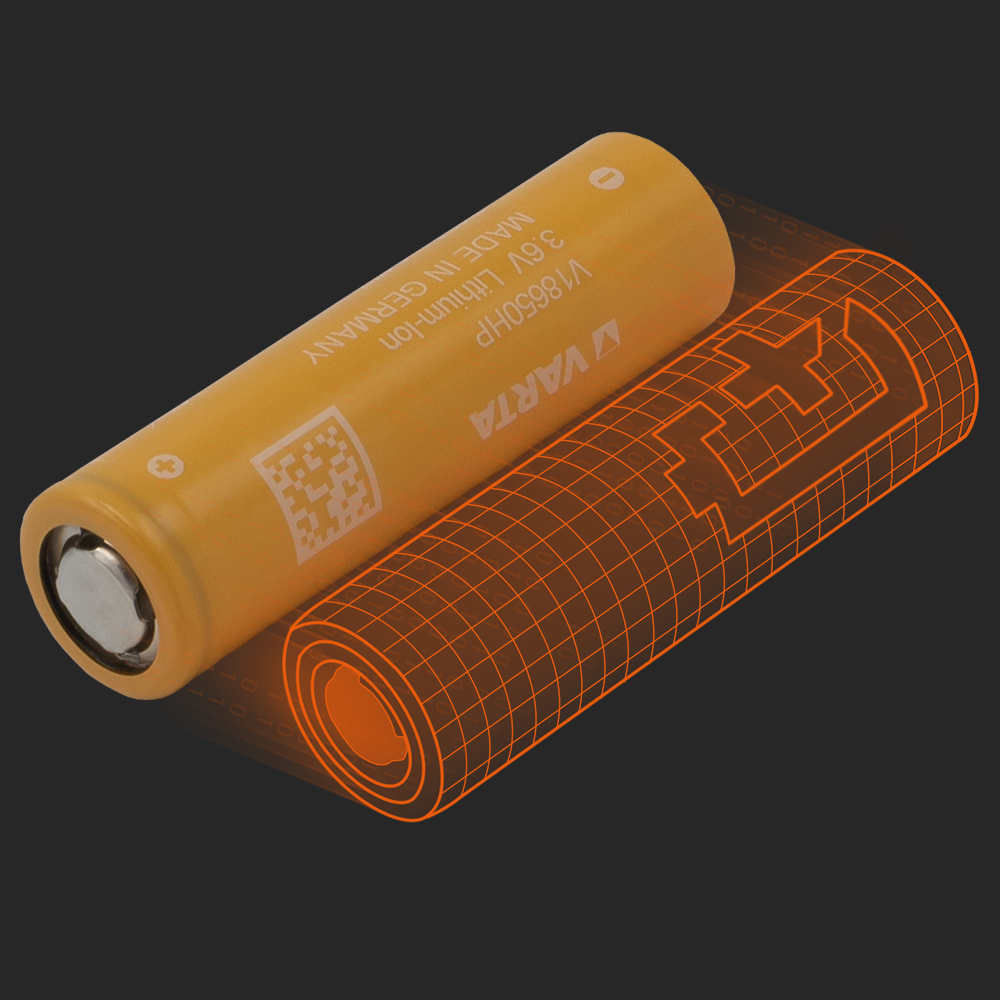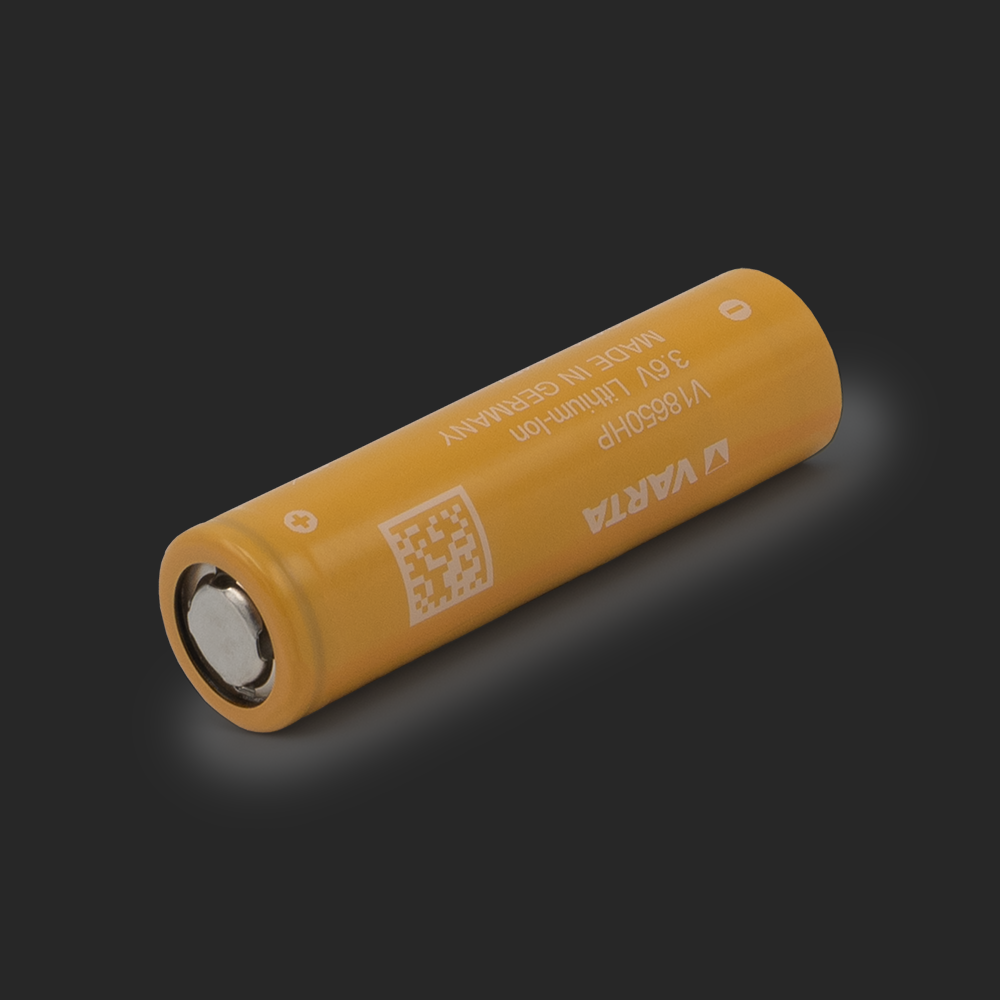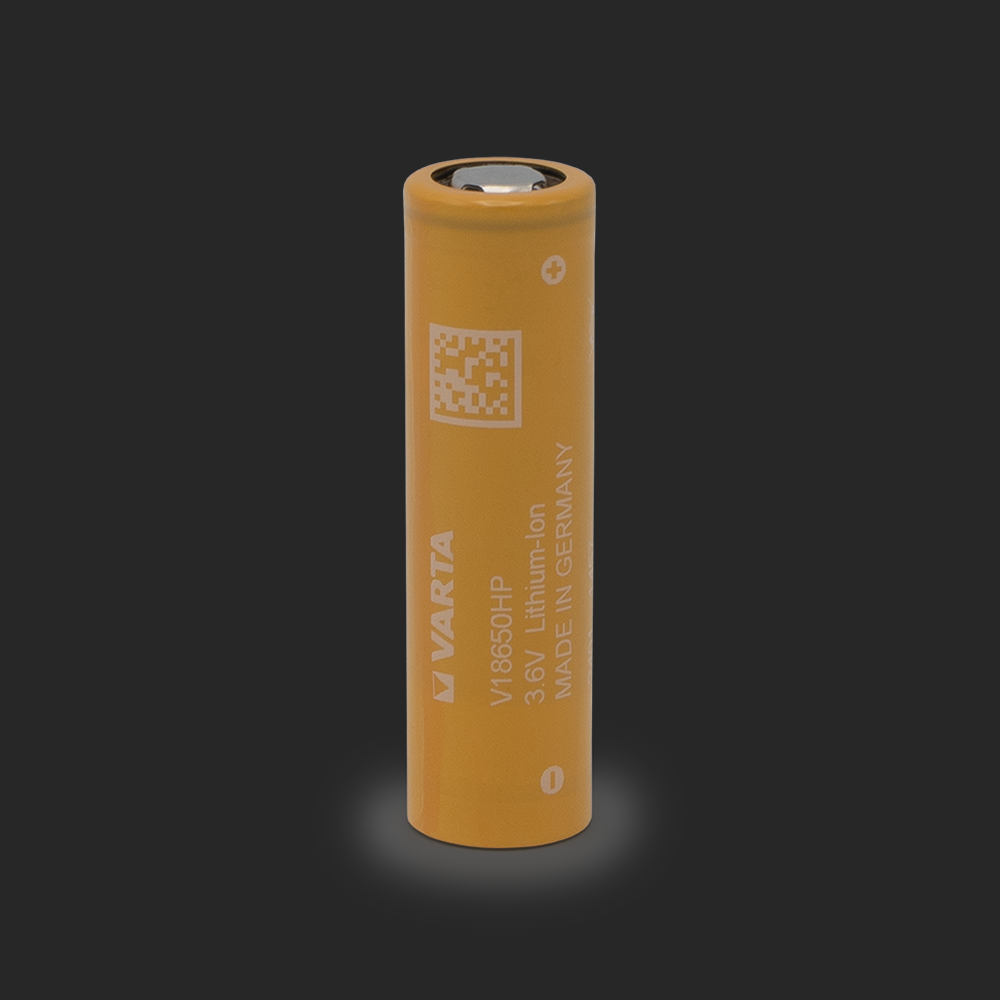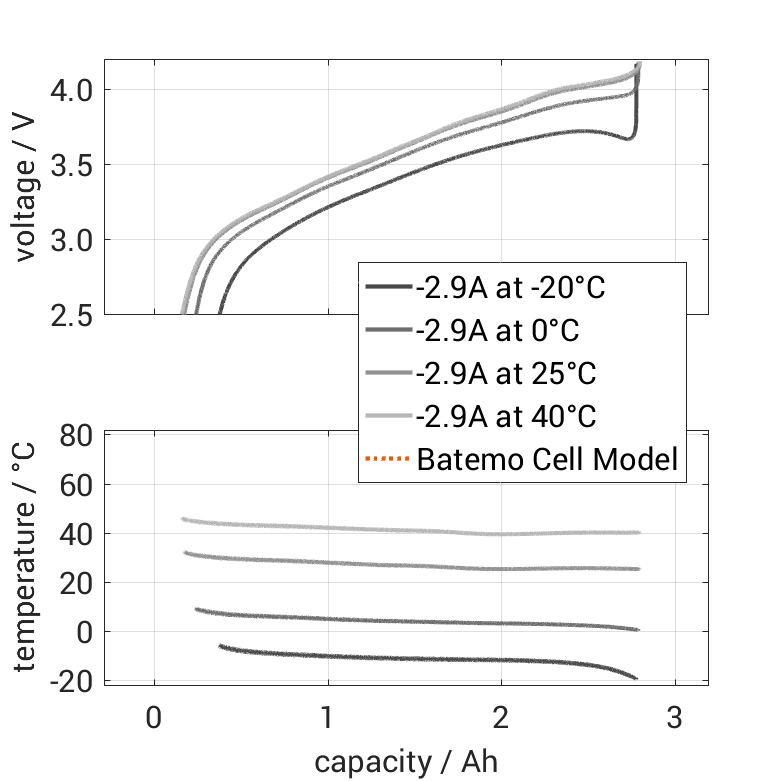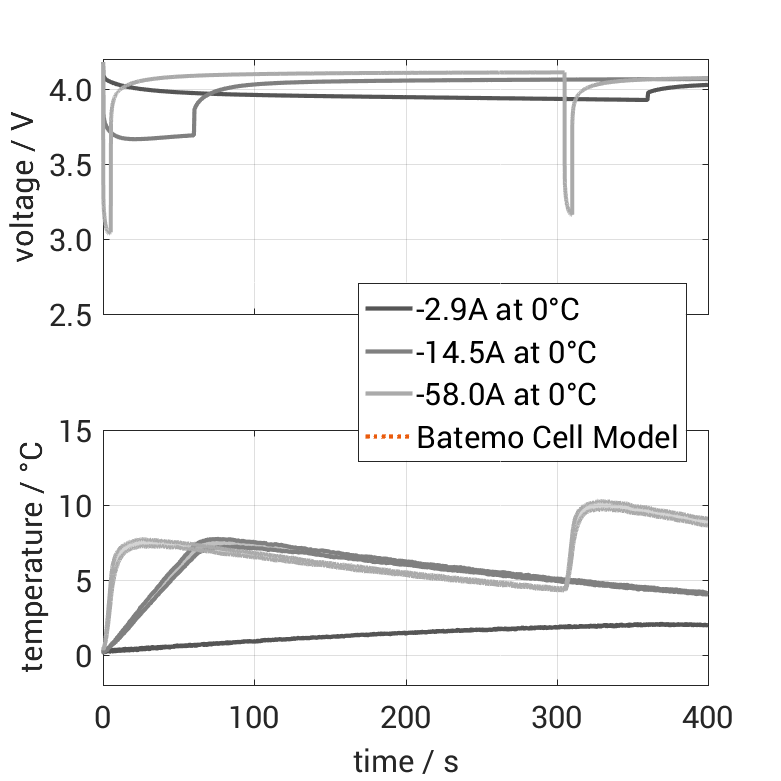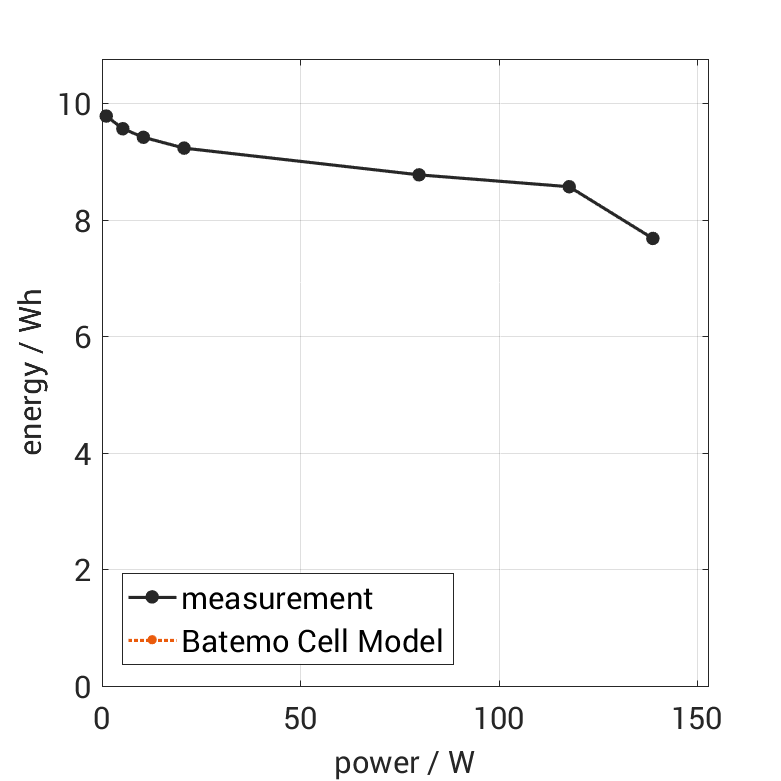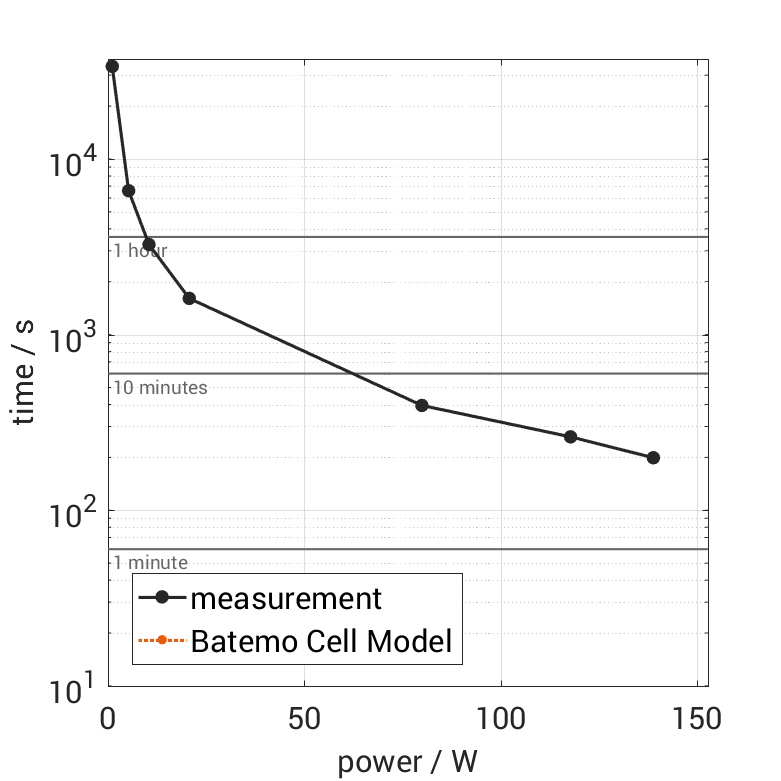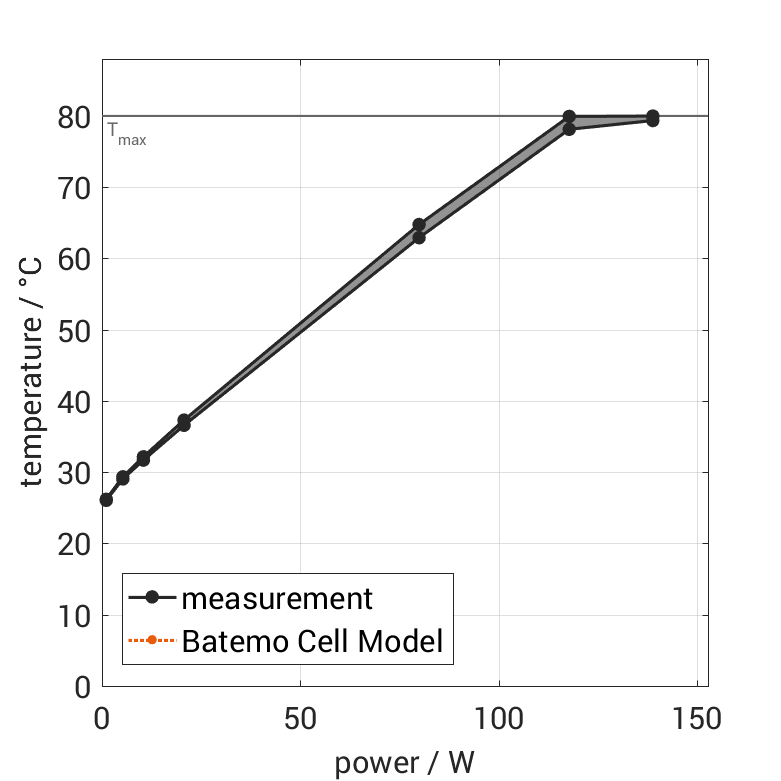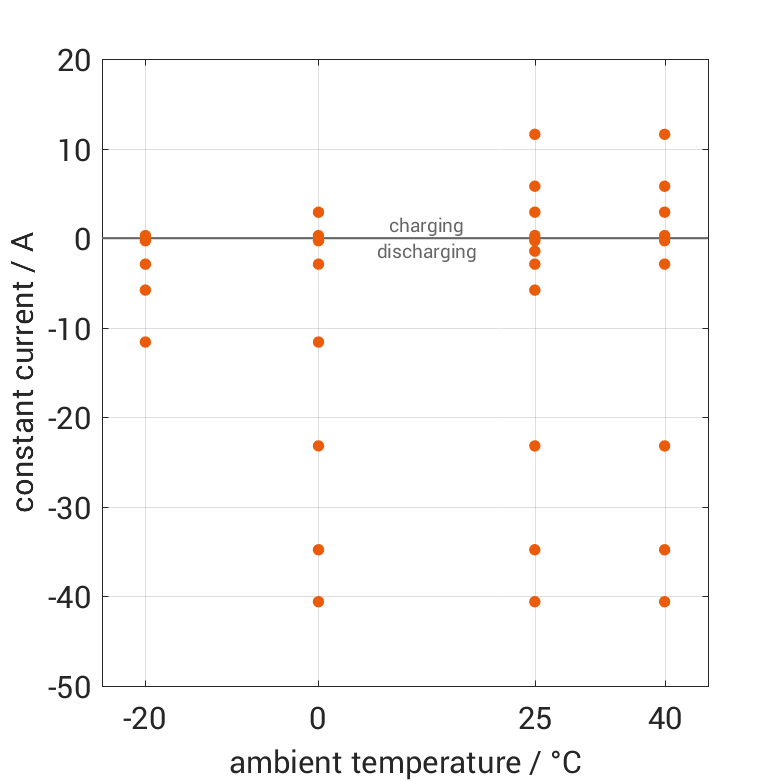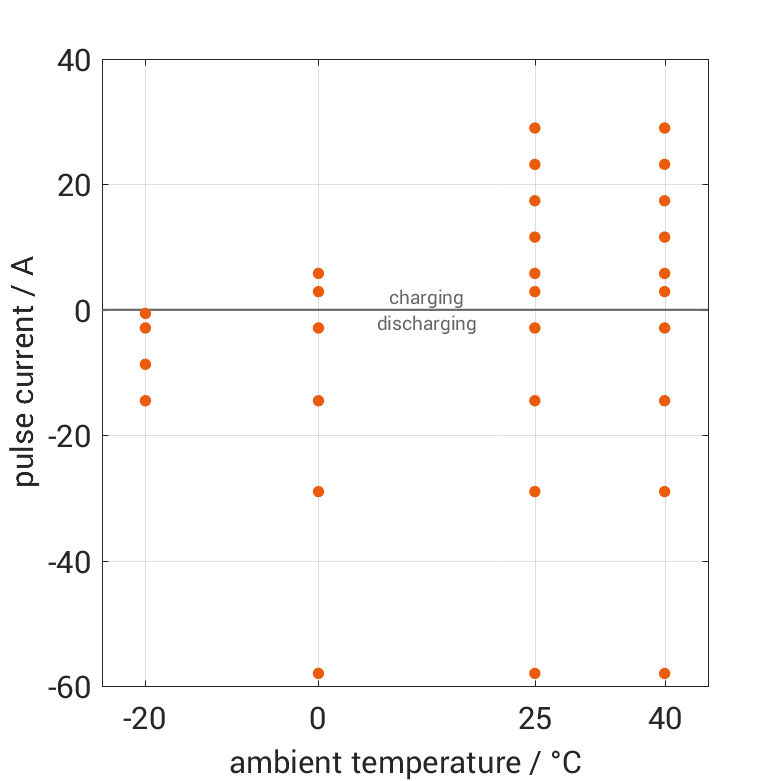V4Drive V18650HP-30(A)
リチウムイオンバッテリーセル V4Drive V18650HP-30(A) に関する全ての情報が手に入ります。全運転領域での詳細な測定データ、高精度かつグローバルに有効な物理バッテリーモデルが含まれています。
| セルの起源 | 自由市場で購入 |
| セルの形式 | 18650 |
| 寸法 | 18.4 x 65.2 mm |
| 重量 | 47.4 g |
| 容量 定義閉じる
公称容量は、利用可能な場合、メーカーのデータシートに基づいています。データシートが利用できない場合、公称容量は推定されます。バテモは、セルを25°Cの周囲温度で100%から放電し、一定の電流でC/10容量を測定しました。0.29A (0.1C) で、2.5Vに達するまで放電しました。熱的境界条件は自然対流です。 |
公称 2.90 Ah C/10 2.71 Ah |
| 電流 定義閉じる
すべての量は、バテモ・バッテリーラボからの測定結果です。 連続電流は、セルを過熱せずに完全に放電できる最大電流です。したがって、セルは25°Cの周囲温度で100%の充電状態(SOC)から定電流で放電され、残りの充電状態が10%になるまで、または下限電圧制限の 2.5V もしくは最大表面温度の90%(72#176;C)に達するまで放電されます。 ピーク電流は、セルが5分間供給できる電流です。したがって、セルは25°Cの周囲温度で100%のSOCから定電流で放電され、5分後に下限電圧制限の 2.5V または最大表面温度の 80°C のいずれかに達するまで放電されます。最大表面温度に達するセルの場合、測定された電流が直接ピーク電流として扱われます。5分後に最大表面温度に達しないが下限電圧制限に先に達するセルの場合、測定された電流は補正係数で調整され、これにより5分以内にセルを最大表面温度まで加熱するであろう電流が推定されます。 熱的境界条件は自然対流です。これらの運転条件は、セルメーカーの仕様を超えている可能性があります。 |
連続 28.7 A ピーク 34.0 A |
| エネルギー 定義閉じる
バテモは、セルを25°Cの周囲温度で100%から一定電流の 0.29A (0.1C) で放電し、2.5V に達するまでのC/10エネルギーを測定しました。熱的境界条件は自然対流です。 |
C/10 9.78 Wh |
| 電力 定義閉じる
すべての量は、バテモ・バッテリーラボからの測定結果です。 連続電力は、セルを過熱することなく完全に放電できる最大の電力です。したがって、セルは25°Cの周囲温度で100%の充電状態(SOC)から一定電流で放電され、残りの充電状態が10%になるまで、または下限電圧制限の 2.5V または最大表面温度の90%(72°C)に達するまで放電されます。 ピーク電力は、セルが5分間供給できる電力です。したがって、セルは25°Cの周囲温度で100%のSOCから一定電流で放電され、5分後に下限電圧制限の 2.5V または最大表面温度の 80°C のいずれかに達するまで放電されます。最大温度制限に達するセルの場合、測定された電力が直接ピーク電力として扱われます。最大表面温度に5分後に達しないが、先に下限電圧制限に達するセルの場合、測定された電力は補正係数で調整され、これにより5分以内にセルを最大表面温度まで加熱するであろう電力が推定されます。 熱的境界条件は自然対流です。これらの運転条件は、セルメーカーの仕様を超えている可能性があります。 |
連続 98.0 W ピーク 116 W |
| エネルギー密度 定義閉じる
エネルギー密度は、C/10エネルギー、セルの重量、およびセルの体積から算出されます。 |
重量エネルギー密度 206 Wh/kg 体積エネルギー密度 565 Wh/l |
| 電力密度 定義閉じる
電力密度は、ピーク電力、セルの重量、およびセルの体積から算出されます。 |
重量電力密度 2.44 kW/kg 体積電力密度 6.68 kW/l |
V4Drive V18650HP-30(A) モデル
リチウムイオンバッテリーセル V4Drive V18650HP-30(A) のバテモ・セルモデルは、世界的に有効な高精度の物理セルモデルです。デジタルツインとして、シミュレーションに基づいて意思決定を行うことで、研究、開発、バッテリー分析にシームレスに統合できます。バテモ・セルモデルの特徴と機能については、詳細をご覧ください。バテモは、以下に示す範囲のバッテリーシミュレーションと測定データを比較することで、バテモ・セルモデルの精度と妥当性を実証しています。検証は広範囲に及び、低温から高温、最大電流まで、全充電状態範囲において実験的特性評価はセルの全動作領域をカバーしています。
| 充電状態範囲 | 0 … 100% |
| 電流範囲 定義閉じる 電流範囲は、バテモ・バッテリーラボで使用される電流限界です。セルの安全な動作範囲の正確な定義については、 V4Drive V18650HP-30(A) データシートを参照してください。 |
-58 A 放電 … 29 A 充電 (-20.0C … 10.0C) |
| 電圧範囲 定義閉じる 電圧範囲は、バテモ・バッテリーラボで使用される電圧限界です。セルの安全な動作電圧範囲の正確な定義については、 V4Drive V18650HP-30(A) データシートを参照してください。 |
2.5 … 4.2 V |
| 温度範囲 定義閉じる 温度範囲は、バテモ・バッテリーラボで使用される温度限界です。セルの安全な動作温度範囲の正確な定義については、 V4Drive V18650HP-30(A) データシートを参照してください。 |
-20 … 80 °C |
さらにバテモ・セルモデルの検証は、非常に透明性をもって行われています。バテモ・セルデータには、生の測定データとシミュレーションデータが含まれています。すべての実験では、電圧、温度、電力、エネルギーの精度が計算されます。これにより、バテモ・セルモデルの有効性を簡単に評価および分析することができます。グラフは、セルの性能を評価するために、セル「V4Drive V18650HP-30(A)」の特性データの選択を示しています。バテモ・セルモデルが完成すると、予測結果が含まれます。
- 放電特性: 電気および熱の放電特性は強く非線形です。
- パルス特性: 異なる電流パルスの形状が大きく変化します。
- エネルギー特性: グラフは、異なる電力で動作する場合にセルがどれだけのエネルギーを供給できるかを示しています。
- 電力特性: セルが供給する電力が多いほど、その電力を供給できる時間は短くなります。
- 熱特性: 熱損失が大きいほど、セルが加熱され、結果として消費電力が高くなります。
実験の定義を表示閉じる
セルは、異なる周囲温度で異なる定電流を用いて100%SOCから放電されます。熱境界条件は自由対流です。電圧が2.5Vまたは表面温度が80°Cに達すると測定が停止します。
セルは、異なる周囲温度で無負荷フェーズを伴う電流パルスを用いて100%SOCから放電されます。熱境界条件は自由対流です。電圧が2.5Vまたは表面温度が80°Cに達すると測定が停止します。グラフにはパルスの一つを視覚化するためのズームビューが表示されます。
セルは、25°Cで異なる定電流を用いて100%SOCから放電されます。熱境界条件は自由対流です。電圧が2.5Vまたは表面温度が80°Cに達すると測定が停止します。グラフには、交換されたエネルギーと実験の平均電力が示されます。
セルは、25°Cで異なる定電流を用いて100%SOCから放電されます。熱境界条件は自由対流です。電圧が2.5Vまたは表面温度が80°Cに達すると測定が停止します。グラフには、実験の継続時間と平均電力が示されます。
セルは、25°Cで異なる定電流を用いて100%SOCから放電されます。熱境界条件は自由対流です。電圧が2.5Vまたは表面温度が80°Cに達すると測定が停止します。グラフには、実験の終了時のセル表面温度と、導出された平均電力が示されます。
平均精度と対応するシミュレーションツールは、バテモ・セルモデルが完成次第公開されます。
V4Drive V18650HP-30(A) データ
バテモは、バッテリーセル V4Drive V18650HP-30(A) の広範な実験的特性評価を提供します。 データには、セルの全運用エリアにおける測定結果が含まれています。以下の説明とグラフは、利用可能な測定結果を説明し、示しています。バテモ・セルビューアーは、データの簡単で迅速な分析、評価、比較を可能にします。詳しくは詳細をご覧ください。
定電流
セルは、さまざまな環境温度で異なる定電流で100% SOCから放電されるか、0% SOCから充電されます。熱境界条件は自由対流です。測定は、電圧が 2.5Vまたは 4.2Vまたは表面温度が 80°Cに達すると停止します。 グラフは、どの環境温度と充電および放電の定電流で測定が利用可能かを示しています。
パルス電流
セルは、さまざまな環境温度で無負荷フェーズに続いて電流パルスで100% SOCから放電されるか、0% SOCから充電されます。熱境界条件は自由対流です。 測定は、電圧が 2.5Vまたは 4.2Vまたは表面温度が 80°Cに達すると停止します。 グラフは、どの環境温度とパルス電流で測定が利用可能かを示しています。
パワープロファイル
| 周囲 温度 |
利用可能な プロファイル |
|---|---|
| -20 °C |  |
| 0 °C |  |
| 25 °C |  |
| 40 °C |  |
セルは、さまざまな環境温度で100% SOCから典型的なパワープロファイルを提供します。熱境界条件は自由対流です。測定は、電圧が 2.5Vまたは表面温度が 80°Cに達すると停止します。テーブルは、どの環境温度でプロファイルが利用可能かを要約しています。
V4Drive V18650HP-30(A) レポート
バテモは、電池セル V4Drive V18650HP-30(A) の詳細なレポートを提供します。レポートには、セルに関する重要な全ての情報が含まれています。この情報は、セルの評価や比較を進めるのに非常に有用です。これは、バッテリーシステム設計に関する決定のための重要な基盤です。詳細をご覧ください。
| 性能概要 |  |
| セルの外装 |  |
| セルの内部 |  |
| 安全機能 |  |
| 電極の微細構造と材料 |  |

